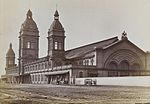Toronto Union Station (1858)
1858 establishments in CanadaRailway stations closed in 1871Railway stations in TorontoUnion stations in Canada

Toronto’s first Union Station was a passenger rail station located west of York Street at Station Street, south of Front Street in downtown Toronto. It was built by the Grand Trunk Railway (GTR) and opened in 1858.
Excerpt from the Wikipedia article Toronto Union Station (1858) (License: CC BY-SA 3.0, Authors, Images).Toronto Union Station (1858)
Front Street West, Old Toronto
Geographical coordinates (GPS) Address Nearby Places Show on map
Geographical coordinates (GPS)
| Latitude | Longitude |
|---|---|
| N 43.644722222222 ° | E -79.383611111111 ° |
Address
Front Street West 151
M5V 2X3 Old Toronto
Ontario, Canada
Open on Google Maps









